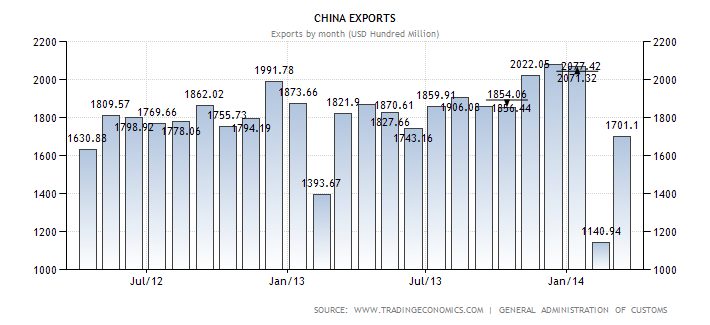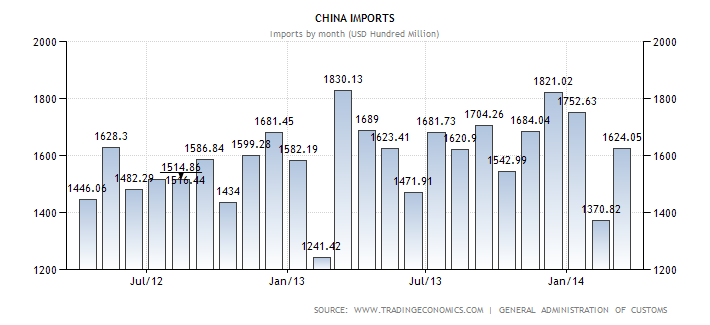Don’t focus on the weak 6.6% year on year fall in Chinese exports in March to $US170.11 billion.
Instead, look at the nearly 8% growth in exports to the rest of the world.
They tell the real story – China’s trade machine remains intact.
Exports were down 18% in February (but that was accounted in part by the Lunar New Year holiday). The fall in March was unexpected as the market had been looking for a small rise.
The main driver appears to be over-invoicing a year ago as suggested by a slump in exports to Hong Kong and Taiwan as Chinese authorities have attempted to stop or cut the inflow of hot money that was speculating on a rise in the value of the currency.
Exports to Hong Kong, a favourite destination for companies wanting to run false invoices (because it is very close to China), plunged 43.6% in March from a year ago.
But exports to the European Union, which are much harder to manipulate because it takes longer to ship the products and get the money rose by nearly 9%, while shipments to the US were up 1.2%.

The value of imports fell 11.3%. That was a surprise seeing imports were up 10% in February. But imports of copper and iron ore were up, though imports of oil and soybeans were down.
Still the country returned to a trade surplus of $US7.1 billion – against the $US23 billion deficit in February and a US$960 million deficit in March last year.

The upshot of yesterday’s figures was that China’s foreign trade volume fell 1% year-on-year in the March quarter to $US965.88 billion.
Exports for the quarter fell 3.4%, year-on-year while imports were up 1.6%, the General Administration of Customs (GAC) said.
The trade surplus for the quarter fell 60% to just $US16.74 billion.
Marketwatch said RBS’s chief China economist Louis Kuijs questioned just how much exports really fell, given the high level of shenanigans in the year-earlier data.
The trade report “is distorted by over-invoicing a year ago, and this distortion peaked in March,” he wrote yesterday. And if this was factored out, RBS estimates that exports really grew 5.2% from a year earlier, “the same pace as in Korea, underscoring that the competitiveness of China’s manufacturing sector is still solid, allowing its export sector to benefit from global demand growth.”
Marketwatch said Kuijs was more puzzled by the heavy fall in imports. His theory? “While we do not have the detailed data, this likely reflects lower commodity imports following an involuntary rise in inventories, as well as the impact of a slowdown in investment.”
Over at TD Securities, Asia research chief Annette Beacher says the results weren’t so bad when compared with the previous month – exports rose about 50% on that basis.
Instead of dwelling on the headline numbers, however, she zeroes in on the nation-by-nation accounts.
“Exports rebounded across the major trading partners as expected, but compared with the February slump, the recovery was rather underwhelming this time for exports to the U.S. and Europe in particular. In contrast, exports to Japan and South Korea returned to recent lofty levels,” wrote Beacher.
The AMP’s Dr Shane Oliver said yesterday that the trade figures and especially the exports were "not nearly as bad as they look. Expect stronger Chinese export growth in the current quarter."
But the apparently weak data hasn’t moved the government.
Chinese Premier Li Keqiang yesterday ruled out major stimulus to fight short-term weakness in the economy. He said job creation was the main policy priority, telling an investment forum on the southern island of Hainan that it did not matter if the growth was a little below the official target of 7.5% for this year
"We will not take, in response to momentary fluctuations in economic growth, short-term and forceful stimulus measures," Li said."We will instead focus more on medium- to long-term healthy development."
China releases its first quarter GDP figures and other data on April 16 – that’s next Wednesday. The market is forecasting annual growth of 7.3%, down from 7.6% in 2013.













